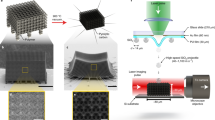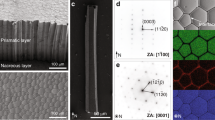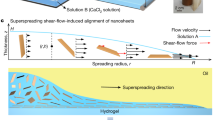Abstract
Nature utilizes the available resources to construct lightweight, strong and tough materials under constrained environmental conditions. The impact surface of the fast-striking dactyl club from the mantis shrimp is an example of one such composite material; the shrimp has evolved the capability to localize damage and avoid catastrophic failure from high-speed collisions during its feeding activities. Here we report that the dactyl club of mantis shrimps contains an impact-resistant coating composed of densely packed (about 88 per cent by volume) ~65-nm bicontinuous nanoparticles of hydroxyapatite integrated within an organic matrix. These mesocrystalline hydroxyapatite nanoparticles are assembled from small, highly aligned nanocrystals. Under impacts of high strain rates (around 104 s−1), particles rotate and translate, whereas the nanocrystalline networks fracture at low-angle grain boundaries, form dislocations and undergo amorphization. The interpenetrating organic network provides additional toughening, as well as substantial damping, with a loss coefficient of around 0.02. An unusual combination of stiffness and damping is therefore achieved, outperforming many engineered materials.
This is a preview of subscription content, access via your institution
Access options
Access Nature and 54 other Nature Portfolio journals
Get Nature+, our best-value online-access subscription
$29.99 / 30 days
cancel any time
Subscribe to this journal
Receive 12 print issues and online access
$259.00 per year
only $21.58 per issue
Buy this article
- Purchase on Springer Link
- Instant access to full article PDF
Prices may be subject to local taxes which are calculated during checkout






Similar content being viewed by others
Data availability
All the data that support the findings of this study are provided in the Supplementary Information and source data. Source data are provided with this paper.
References
Bhatnagar, A. Lightweight Ballistic Composites: Military and Law-Enforcement Applications (Woodhead, 2016).
Dalili, N., Edrisy, A. & Carriveau, R. A review of surface engineering issues critical to wind turbine performance. Renew. Sustain. Energy Rev. 13, 428–438 (2009).
Munch, E. et al. Tough, bio-inspired hybrid materials. Science 322, 1516–1520 (2008).
Grunenfelder, L. et al. Bio-inspired impact-resistant composites. Acta Biomater 10, 3997–4008 (2014).
Yaraghi, N. A. & Kisailus, D. Biomimetic structural materials: inspiration from design and assembly. Annu Rev. Phys. Chem. 69, 23–57 (2018).
Chen, P. Y., McKittrick, J. & Meyers, M. A. Biological materials: functional adaptations and bioinspired designs. Prog. Mater. Sci. 57, 1492–1704 (2012).
Yin, Z., Hannard, F. & Barthelat, F. Impact-resistant nacre-like transparent materials. Science 364, 1260–1263 (2019).
Gu, G. X., Takaffoli, M. & Buehler, M. J. Hierarchically enhanced impact resistance of bioinspired composites. Adv. Mater. 29, 1700060 (2017).
Huang, W., Zaheri, A., Jung, J.-Y., Espinosa, H. D. & Mckittrick, J. Hierarchical structure and compressive deformation mechanisms of bighorn sheep (Ovis canadensis) horn. Acta Biomater. 64, 1–14 (2017).
Wegst, U. G. K., Bai, H., Saiz, E., Tomsia, A. P. & Ritchie, R. O. Bioinspired structural materials. Nat. Mater. 14, 23–36 (2015).
Huang, W. et al. Multiscale toughening mechanisms in biological materials and bioinspired designs. Adv. Mater. 31, 1901561 (2019).
Schaffler, M., Radin, E. & Burr, D. Mechanical and morphological effects of strain rate on fatigue of compact bone. Bone 10, 207–214 (1989).
Launey, M. E., Chen, P.-Y., McKittrick, J. & Ritchie, R. Mechanistic aspects of the fracture toughness of elk antler bone. Acta Biomater. 6, 1505–1514 (2010).
Li, L. & Ortiz, C. Pervasive nanoscale deformation twinning as a catalyst for efficient energy dissipation in a bioceramic armour. Nat. Mater. 13, 501–507 (2014).
Shin, Y. A. et al. Nanotwin-governed toughening mechanism in hierarchically structured biological materials. Nat. Commun. 7, 10772 (2016).
Pellman, E. J., Viano, D. C., Tucker, A. M., Casson, I. R. & Waeckerle, J. F. Concussion in professional football: reconstruction of game impacts and injuries. Neurosurgery 53, 799–814 (2003).
Weaver, J. C. et al. The stomatopod dactyl club: a formidable damage-tolerant biological hammer. Science 336, 1275–1280 (2012).
Caldwell, R. L. & Dingle, H. Stomatopods. Sci. Am. 234, 80–89 (1976).
Yaraghi, N. A. et al. A sinusoidally architected helicoidal biocomposite. Adv. Mater. 28, 6835–6844 (2016).
Amini, S., Tadayon, M., Idapalapati, S. & Miserez, A. The role of quasi-plasticity in the extreme contact damage tolerance of the stomatopod dactyl club. Nat. Mater. 14, 943–950 (2015).
Grunenfelder, L. K. et al. Ecologically driven ultrastructural and hydrodynamic designs in stomatopod cuticles. Adv. Mater. 30, 1705295 (2018).
Suksangpanya, N., Yaraghi, N. A., Kisailus, D. & Zavattieri, P. Twisting cracks in Bouligand structures. J. Mech. Behav. Biomed. 76, 38–57 (2017).
Cölfen, H. & Mann, S. Higher‐order organization by mesoscale self‐assembly and transformation of hybrid nanostructures. Angew. Chem. Int. Ed. 42, 2350–2365 (2003).
De Yoreo, J. J. et al. Crystallization by particle attachment in synthetic, biogenic, and geologic environments. Science 349, aaa6760 (2015).
Rinaudo, M. Chitin and chitosan: properties and applications. Prog. Polym. Sci. 31, 603–632 (2006).
Neville, A. & Luke, B. A two-system model for chitin–protein complexes in insect cuticles. Tissue Cell 1, 689–707 (1969).
Watson, M. L. Staining of tissue sections for electron microscopy with heavy metals. J. Cell Biol. 4, 475–478 (1958).
Gordon, L. M. & Joester, D. Nanoscale chemical tomography of buried organic–inorganic interfaces in the chiton tooth. Nature 469, 194–197 (2011).
Li, H., Xin, H. L., Muller, D. A. & Estroff, L. A. Visualizing the 3D internal structure of calcite single crystals grown in agarose hydrogels. Science 326, 1244–1247 (2009).
Kim, Y.-Y. et al. Tuning hardness in calcite by incorporation of amino acids. Nat. Mater. 15, 903 (2016).
McKenzie, B. E. et al. Controlling internal pore sizes in bicontinuous polymeric nanospheres. Angew. Chem. Int. Ed. 54, 2457–2461 (2015).
Zhang, Q., Liu, S.-J. & Yu, S.-H. Recent advances in oriented attachment growth and synthesis of functional materials: concept, evidence, mechanism, and future. J. Mater. Chem. 19, 191–207 (2009).
Cöelfen, H. & Antonietti, M. Mesocrystals and Nonclassical Crystallization (John Wiley & Sons, 2008).
Nudelman, F. et al. The role of collagen in bone apatite formation in the presence of hydroxyapatite nucleation inhibitors. Nat. Mater. 9, 1004–1009 (2010).
Song, R. Q. & Cölfen, H. Mesocrystals—ordered nanoparticle superstructures. Adv. Mater. 22, 1301–1330 (2010).
Nielsen, J. H. Remaining stress-state and strain-energy in tempered glass fragments. Glass Struct. Eng. 2, 45–56 (2017).
Cho, K. R. et al. Direct observation of mineral–organic composite formation reveals occlusion mechanism. Nat. Commun. 7, 10187 (2016).
Kim, Y.-Y. et al. An artificial biomineral formed by incorporation of copolymer micelles in calcite crystals. Nat. Mater. 10, 890–896 (2011).
Sato, M., Schwarz, W. H. & Pollard, T. D. Dependence of the mechanical properties of actin/α-actinin gels on deformation rate. Nature 325, 828–830 (1987).
Jin, K., Feng, X. & Xu, Z. Mechanical properties of chitin–protein interfaces: a molecular dynamics study. BioNanoScience 3, 312–320 (2013).
Ashby, M. F. Materials Selection in Mechanical Design (Butterworth-Heinemann, 2011).
Unwin, A. P. et al. Escaping the Ashby limit for mechanical damping/stiffness trade-off using a constrained high internal friction interfacial layer. Sci. Rep. 8, 2454 (2018).
Chung, D. Materials for vibration damping. J. Mater. Sci. 36, 5733–5737 (2001).
Huang, Z. W. et al. Uncovering high-strain rate protection mechanism in nacre. Sci. Rep. 1, 148 (2011).
Chen, M., McCauley, J. W. & Hemker, K. J. Shock-induced localized amorphization in boron carbide. Science 299, 1563–1566 (2003).
Huang, W. et al. How water can affect keratin: hydration‐driven recovery of bighorn sheep (Ovis canadensis) horns. Adv. Funct. Mater. 29, 1901077 (2019).
Cho, H. et al. Engineering the mechanics of heterogeneous soft crystals. Adv. Funct. Mater. 26, 6938–6949 (2016).
Lee, J.-H., Wang, L., Boyce, M. C. & Thomas, E. L. Periodic bicontinuous composites for high specific energy absorption. Nano Lett. 12, 4392–4396 (2012).
Gutierrez, J., Tercjak, A. & Mondragon, I. Conductive behavior of high TiO2 nanoparticle content of inorganic/organic nanostructured composites. J. Am. Chem. Soc. 132, 873–878 (2010).
Moore, D. G., Barbera, L., Masania, K. & Studart, A. R. Three-dimensional printing of multicomponent glasses using phase-separating resins. Nat. Mater. 19, 212–217 (2020).
Labuda, A., Kocuń, M., Meinhold, W., Walters, D. & Proksch, R. Generalized hertz model for bimodal nanomechanical mapping. Beilstein J. Nanotechnol. 7, 970–982 (2016).
Kocun, M., Labuda, A., Meinhold, W., Revenko, I. N. & Proksch, R. Fast, high resolution, and wide modulus range nanomechanical mapping with bimodal tapping mode. ACS Nano 11, 10097–10105 (2017).
Benaglia, S., Amo, C. A. & Garcia, R. Fast, quantitative and high resolution mapping of viscoelastic properties with bimodal AFM. Nanoscale 11, 15289–15297 (2019).
Asif, S. S., Wahl, K. & Colton, R. Nanoindentation and contact stiffness measurement using force modulation with a capacitive load-displacement transducer. Rev. Sci. Instrum. 70, 2408–2413 (1999).
Syed Asif, S., Wahl, K., Colton, R. & Warren, O. Quantitative imaging of nanoscale mechanical properties using hybrid nanoindentation and force modulation. J. Appl. Phys. 90, 1192–1200 (2001).
Plimpton, S. Fast parallel algorithms for short-range molecular dynamics. J. Comput. Phys. 117, 1–19 (1995).
Lin, T.-J. & Heinz, H. Accurate force field parameters and pH resolved surface models for hydroxyapatite to understand structure, mechanics, hydration, and biological interfaces. J. Phys. Chem. C 120, 4975–4992 (2016).
Ching, W., Rulis, P. & Misra, A. Ab initio elastic properties and tensile strength of crystalline hydroxyapatite. Acta Biomater. 5, 3067–3075 (2009).
Espanol, M., Portillo, J., Manero, J.-M. & Ginebra, M.-P. Investigation of the hydroxyapatite obtained as hydrolysis product of α-tricalcium phosphate by transmission electron microscopy. CrystEngComm 12, 3318–3326 (2010).
Zhao, S. et al. Shock-induced amorphization in silicon carbide. Acta Mater. 158, 206–213 (2018).
Lin, S., Cai, Z., Wang, Y., Zhao, L. & Zhai, C. Tailored morphology and highly enhanced phonon transport in polymer fibers: a multiscale computational framework. npj Comput. Mater. 5, 126 (2019).
Ramachandramoorthy, R., Gao, W., Bernal, R. & Espinosa, H. High strain rate tensile testing of silver nanowires: rate-dependent brittle-to-ductile transition. Nano Lett. 16, 255–263 (2016).
Fang, Q., Tian, Y., Wu, H. & Li, J. Revealing the deformation mechanism of amorphous polyethylene subjected to cycle loading via molecular dynamics simulations. RSC Adv. 8, 32377–32386 (2018).
Acknowledgements
We acknowledge N. A. Yaraghi for his work and support in the initial stage of the project. We also acknowledge L. G. Hector for his support and discussions on the application of these designs. We acknowledge funding from the Air Force Office of Scientific Research Multi-University Research Initiative (MURI AFOSR-FA9550-15-1-0009); D.K. also acknowledges funding from the Air Force Office of Scientific Research (AFOSR-FA9550-10-1-0322, AFOSR-FA9550-17-1-0449 and AFOSR-FA9550-18-1-0424) and the Army Research Office (ARO-W911NF-16-1-0208).
Author information
Authors and Affiliations
Contributions
D.K. initiated and planned the project. W.H. performed the sample preparation, characterization and mechanical experiments. M.S., N.G.-Z. and P.Z. performed the computational simulations and provided analyses and writing on simulations. N.D.K. and J.L. did the AFM tests and data analysis. L.C. performed TGA and DSC, T.W. performed the TEM sample staining and EDX, S.B. and W.H. performed the in situ TEM mechanical tests. D.S. and P.M. performed the nanoindentation and nanoDMA tests and data analysis. K.N.B. provided support on the TEM experiments as well as data analysis. R.C. provided discussion on the evolutionary and biological aspects of the manuscript. W.H. and D.K. wrote the manuscript. All the authors made edits and revisions on the final draft.
Corresponding author
Ethics declarations
Competing interests
The authors declare no competing interests.
Additional information
Publisher’s note Springer Nature remains neutral with regard to jurisdictional claims in published maps and institutional affiliations.
Extended data
Extended Data Fig. 1 TEM and HRTEM micrographs of hydroxyapatite (HAP) composite nanoparticles within the impact surface.
TEM and HRTEM micrographs of hydroxyapatite (HAP) composite nanoparticles within the impact surface. a, Secondary HAP nanoparticles marked with red outlines. The yellow dashed lines show the alignment of primary particles within a single secondary HAP particle. b, SAED pattern from the TEM image in (a). The small arcs indicate slight mis-alignments of nanocrystals within the secondary particle. c, HRTEM image of a single HAP particle, with brighter contrast regions suggesting the presence of a secondary phase. d, FFT of the particle in (c). (e) HRTEM of the (100) lattice in the HAP nanocrystals. Insets: Stacking faults are observed within primary particles. Three independent dactyl clubs from 3 different mantis shrimps were examined in TEM. Similar results as shown in (a–e) were observed.
Extended Data Fig. 2 HRTEM of uranyl acetate and lead citrate stained HAP nanoparticles on the impact surface.
HRTEM of uranyl acetate and lead citrate stained HAP nanoparticles on the impact surface. The reduced ordering in protein complexes provide a higher permeability for the heavy metal staining solution, resulting in greater contrast in the TEM micrograph. a, HRTEM of a HAP nanoparticle, showing chitin macromolecules wrapping around the HAP crystal. b, FFT of the HAP crystal lattice indicated with a purple box in (a). Both diffraction spots and rings are observed in the FFT pattern. Inverse Fast Fourier Transform (IFFT) is performed on the diffraction spots and rings, separately. The yellow box (upper, right inset) shows the HAP lattice after IFFT, while red box (lower, left) shows the location of chitin macromolecules. c, HRTEM of a HAP nanoparticle. d, FFT of the HAP nanoparticle in (c). The (201) reflection from HAP is indicated with a yellow arrow, whereas the (003) planes of chitin (diffraction ring) are highlighted by the green arrow. e, f, HRTEM showing the interface between chitin macromolecules and a HAP nanocrystal. The (201) crystal planes of HAP appear adjacent with (003) planes of chitin, suggesting a potential epitaxial growth of HAP on chitin macromolecules. Three independent dactyl clubs from 3 different mantis shrimps were examined in HRTEM. Similar results as shown in (a–f) were observed.
Extended Data Fig. 3 Strain-rate-dependent behaviour in the impact surface of dactyl club.
Strain-rate-dependent behaviour in the impact surface of dactyl club. Load–displacement curves of quasi-static nanoindentation on the impact surface with a sharp cube corner a, and a blunt spherical indenter head b, c–f, SEM micrographs of the damage modes in quasi-static nanoindentation and impacts with sharp and blunt indenter heads. g, SEM images showing particle pile up and crack initiation and propagation. h, i, TEM images of HAP nanoparticles after indentation. The secondary HAP particles remain intact after quasi-static nanoindentation. Quasi-static indentation tests on five independent locations within two different dactyl clubs were performed and examined. Similar damage modes shown in (c–i) were observed.
Extended Data Fig. 4 In situ compression tests of single HAP nanoparticles.
In situ compression tests of single HAP nanoparticles. a–d, HAP nanoparticle before and after compression tests, indicating particle breakage. Five different nanoparticles were tested. Similar particle breakage was noticed. e, Load versus displacement curves of different tests. The breakage of particles and energy dissipation events are marked with back arrows. The total energy dissipation during compression is calculated from the integration of the force-displacement curves.
Supplementary information
Supplementary Information
Supplementary Figs. 1–8 and discussion.
Supplementary Video 1
HAP nanoparticles at different tilt angles in TEM.
Source data
Source Data Fig. 3
Source data for Fig. 3h–j.
Source Data Fig. 5
Source data for Fig. 5j.
Source Data Fig. 6
Source data for Fig. 6e, f.
Source Data Extended Data Fig. 3
Source data for Extended Data Fig. 3a,b.
Source Data Extended Data Fig. 4
Source data for Extended Data Fig. 4e.
Rights and permissions
About this article
Cite this article
Huang, W., Shishehbor, M., Guarín-Zapata, N. et al. A natural impact-resistant bicontinuous composite nanoparticle coating. Nat. Mater. 19, 1236–1243 (2020). https://doi.org/10.1038/s41563-020-0768-7
Received:
Accepted:
Published:
Issue Date:
DOI: https://doi.org/10.1038/s41563-020-0768-7
This article is cited by
-
Redefined ion association constants have consequences for calcium phosphate nucleation and biomineralization
Nature Communications (2024)
-
Hierarchically structured bioinspired nanocomposites
Nature Materials (2023)
-
Tissue structure and mechanical properties of the exoskeleton of the huge claws of the mud crab, Scylla serrata
Journal of Materials Science (2023)
-
Anomalous inapplicability of nacre-like architectures as impact-resistant templates in a wide range of impact velocities
Nature Communications (2022)
-
Bioinspired Strategies for Excellent Mechanical Properties of Composites
Journal of Bionic Engineering (2022)



